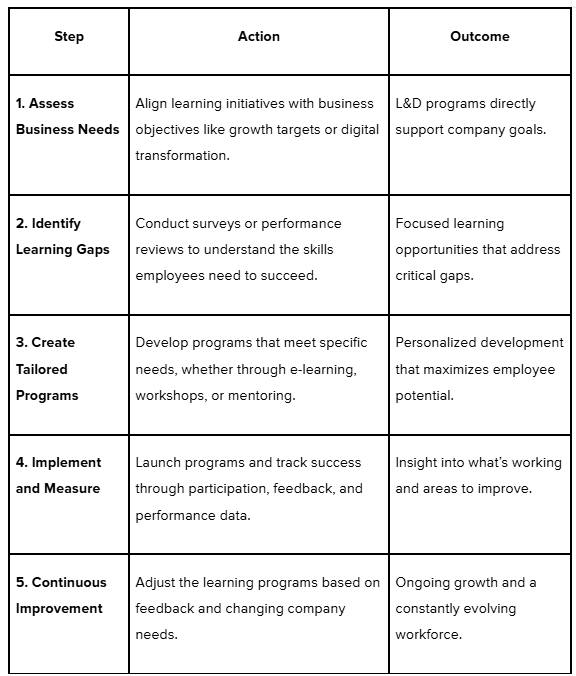
When your staff stops learning, they stop growing. And if they stop growing, they look elsewhere. Studies have indicated that 60% of staff would prefer to work for an organization that has strong professional development rather than one that provides average pay raises.
Despite this, there are simply too many businesses that treat Learning and Development (L&D) as a one-time isolated incident rather than an ongoing strategy. Without a structured approach, the skills shortage widens, productivity suffers, and retaining top talent becomes an issue.
An effective L&D program does more than train. It builds future leaders, improves performance, and gives businesses a competitive edge. This guide will define corporate L&D, why it matters, and how to design a strategy that yields measurable business results.
What Is Corporate L&D?
An exceptionally performing staff member is assigned to a leadership role. However, due to a lack of proper training, they struggle to adapt to their new responsibilities.
This highlights a gap in the organization’s L&D strategies. Corporate L&D needs to be a methodical process through which an organization provides training and development opportunities to its employees. Its primary aim is to ensure that the workforce possesses the right skills and knowledge to meet current and future business requirements.
Key Components of Corporate L&D
- Onboarding and Orientation: Introducing new hires to the company’s culture, policies, and expectations to facilitate a smooth transition into their roles.
- Continuous Upskilling and Reskilling: Offering ongoing training programs to help employees adapt to changing job requirements and technological advancements.
- Leadership Development: Preparing employees for managerial and executive roles through targeted training and mentorship programs.
- Compliance and Regulatory Training: Ensuring that employees are aware of and adhere to industry regulations and company policies.
- Corporate Universities and Internal Academies: Establishing in-house educational platforms to provide tailored learning experiences aligned with organizational objectives.
An effective L&D strategy builds the staff’s capability and results in higher job satisfaction, higher retention levels, and organizational success. Committed businesses that are engaged in continuous learning derive real business benefits.
To fully understand the benefit, let’s explore why L&D matters to both employees and the organization.
Why Corporate L&D Is Essential
Corporate L&D really benefits the entire organization. Recruits need to be onboarded well to excel. Mid-career individuals need to be upskilled to remain competitive. Finally, emerging leaders rely on systematic development to assume more responsibility. As the staff develops, the organization develops along with them.
By investing in L&D, businesses are more productive and less prone to errors. Employees who receive regular training are more efficient and bring higher value to the organization.
Another important advantage of good L&D systems is that they encourage growing leaders and establish a multi-generational workforce from within.
A well-defined L&D program is an investment that determines the future of an organization. To deliver the best outcomes, you need a strong team. The following are some important competencies every L&D professional ought to possess.
Essential Skills for L&D Professionals
A great L&D program is only as strong as the people behind it. L&D professionals don’t just deliver training; they design strategies, foster engagement, and align learning with business goals. To build programs that drive real impact, they need a combination of technical expertise, strategic thinking, and interpersonal skills:
1. Personal Capabilities: The Human Side of L&D
L&D isn’t just about content; it’s about people, too. Strong interpersonal skills help professionals connect with employees, understand learning needs, and drive engagement. These include communication, empathy, and collaboration.
2. Professional Capabilities: The Technical Skills That Matter
The ability to design and deliver effective training programs is essential. L&D professionals must understand instructional design principles to create structured, engaging, and results-driven learning experiences. As organizations shift toward e-learning, video-based training, and interactive modules, digital learning expertise is becoming increasingly important. Knowing how to integrate technology into learning programs enhances accessibility and engagement.
3. Organizational Capabilities: Aligning L&D with Business Strategy
For L&D to drive real impact, it must connect to broader company goals. Learning initiatives should support workforce planning, performance objectives, and long-term business strategy. Strong leadership skills also help L&D professionals champion the importance of continuous learning, influence key stakeholders, and secure executive buy-in.
Developing these skills takes time, experience, and a commitment to continuous learning. But strategic implementation is necessary regardless.
Building an L&D Strategy That Delivers Results
Building an L&D strategy begins with understanding business objectives. From there, the plan must focus on employee needs and how learning can directly impact their productivity and overall company growth. A good strategy also involves tracking key metrics that help refine and measure success.
Here’s an actionable, five-step L&D strategy framework:
Despite the benefits of a well-crafted L&D program, implementation can be tricky. To ensure you are ready for any speed bumps, let’s look at the most frequent challenges companies encounter.
Common Challenges in Corporate L&D
Even the best training programs are full of challenges. Early identification and addressing these challenges are essential to making your training programs successful.
1. Engagement: Sustaining Motivation
Ensuring a good turnout can be difficult if the information given comes across as irrelevant to your employees.
Example: A company rolls out a mandatory course, but employees are disinterested because the training does not appear to be applicable to their job. The result is low attendance and completion.
Solution: Increase interactivity and relevance in training. Personalize learning pathways, link learning to specific job duties, and use real-life examples. Real-time feedback and gamification can also be powerful motivators.
2. Effectiveness Measurement: Proving ROI
It is often difficult to prove the effectiveness of training programs and their return on investment (ROI). Many organizations struggle to connect training initiatives to quantifiable business outcomes.
Example: A company initiates a leadership training program but cannot link it to measurable outcomes like higher productivity or employee retention.
Solution: Set clear, measurable goals early. Track course completion rates, feedback, and business performance indicators (such as reduced turnover or increased sales) to evaluate success. This helps demonstrate the program’s value and improve future training.
3. Technology Integration: Ensuring Accessibility
With the rise of digital learning platforms, some employees struggle to adopt new tools, impacting training effectiveness.
Example: A company implements a new Learning Management System (LMS), but employees find the interface confusing and avoid using it.
Solution: Ensure the learning system is user-friendly and provides training on how to use it. Ongoing support and guidance will help employees feel more confident and engaged with the platform.
4. Change Management: Navigating Organizational Shifts
Many employees resist change, especially when new systems or processes are introduced. Effective change management strategies are crucial.
Example: A company introduces a new software tool, but employees hesitate to use it due to concerns about the learning curve and workflow disruptions.
Solution: Implement gradual training to help employees gain confidence in the new system. Communicate the benefits, provide hands-on learning, and offer peer support to ensure a smooth transition.
5. Limited Resources: Maximizing Impact with a Budget
Many L&D teams face budget constraints, making it challenging to roll out large-scale training programs.
Example: A company wants to implement an extensive training program but lacks the budget for expensive courses or workshops.
Solution: Focus on cost-effective approaches like microlearning, e-learning, and virtual workshops. Collaborate with other departments to pool resources and use free or low-cost learning tools to expand training impact.
Having identified these common challenges, it’s time to move forward with the right approach. In the next section, we’ll outline the best practices that ensure your L&D strategy drives engagement, growth, and results.
The Future of Corporate L&D
As technology evolves, Corporate L&D is shifting toward more dynamic, personalized, and accessible learning strategies.
Organizations are adopting new methods to promote continuous learning, skill development, and workforce adaptability, such as:
- AI-Driven Personalization: AI is enabling tailored learning journeys for employees. By analyzing learning patterns, AI-powered platforms recommend personalized training modules that align with an employee’s career path and skill gaps.
- Microlearning Modules: Microlearning delivers short, focused training sessions that employees can easily access when needed. L&D Society research states that 71% of executives believe that staff productivity is improved as a direct result of microlearning.
- Immersive Learning Technologies: Virtual and Augmented Reality (VR/AR) are transforming L&D by offering hands-on learning experiences in simulated environments.
- Continuous Learning Culture: As the job market evolves, ongoing education becomes a necessity. Organizations will prioritize professional development, ensuring employees engage in learning throughout their careers, from onboarding to leadership training.
- Integrated Learning Solutions: Embedding learning into employees’ daily tasks makes training more relevant and practical. Learning in the flow of work allows employees to access training content as they perform their jobs, making it easier to retain and apply knowledge.
By embracing these trends and adapting accordingly, organizations can build an agile, skilled workforce that is prepared for future challenges. The future of corporate L&D lies in creating flexible, dynamic learning ecosystems that support both individual growth and business success.
Conclusion
Corporate L&D is becoming a core business function that closely aligns with organizational goals. As we’ve described, the future of L&D is based on AI-facilitated personalization, microlearning, immersive technology, and the establishment of a culture of ongoing learning.
These trends are not only revolutionizing how training is delivered but also how we engage and empower employees to tackle future challenges.
91% of L&D professionals agree continuous learning is more important than ever for career success.
To stay one step ahead, companies need a strategic framework that facilitates personalized learning journeys, continuous growth, and the integration of learning into daily work.
At EI, we specialize in L&D consulting and advisory, helping organizations develop effective learning strategies that align with both business objectives and employee aspirations. With our expertise in cutting-edge learning solutions, your organization can build an agile, skilled, and future-ready workforce.
Ready to transform your L&D strategy and future-proof your organization? Contact us today to learn how our expertise can help you create a future-ready learning culture.




